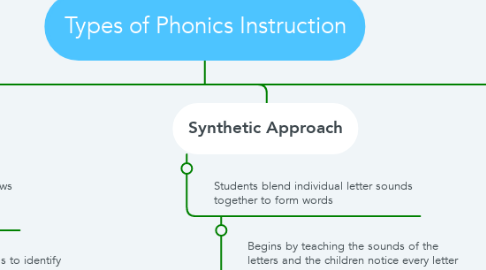
1. Analytic Approach
1.1. Begins with words that a child knows (semantics) and breaks down into component parts
1.1.1. Students can compare words to identify patterns and apply this knowledge to new words
1.1.1.1. Students can examine word families to make analogies between segment words
1.1.1.1.1. Examples:
1.1.1.1.2. Start with a word a child already knows whether it is cat, sat, hat, etc. and have them break the word into phonemes. Have the child turn the word cat into /C/ /A/ /T/
1.1.1.1.3. Demonstrate analogy phonics by teaching onset-rimes or word families such as how is the word bl-ock like the word cl-ock?
1.1.1.1.4. An effective approach would be Word Study as it is a new way of teaching spelling
2. Synthetic Approach
2.1. Students blend individual letter sounds together to form words
2.1.1. Begins by teaching the sounds of the letters and the children notice every letter in the word
2.1.1.1. Examples:
2.1.1.2. Read decodable stories and have the children practice decoding text that was read
2.1.1.3. Give students the sounds of letters and have them practice blending by writing what they hear on wipe off boards and create a word.
2.1.1.4. Orton Gillingham method
3. Embedded
3.1. Phonics taught in context of reading stories or when problems arise; used when students have difficulty reading certain words
3.1.1. Not systematic; not all phonics elements are taught, only what is needed during a reading lesson
3.1.2. Lessons begin with a teacher reading a book and identifying teachable moments
3.1.2.1. Examples:
3.1.2.2. An effective instruction would be if a teacher is doing a guided reading, shared reading, or read aloud and notices that there are a lot of short a words in it so they decide to teach what a short a sound is to the class.
3.1.2.3. A teacher knows what a child needs help with so during a guided reading lesson, the teacher can incorporate embedded phonics when they come across a word that a child may struggle with
3.1.2.4. Teachers can use picture clues, stories, songs or key words when teaching embedded phonics
